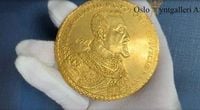In a historic auction held on May 10, 2025, a rare Polish 100 ducat coin, known as the "Chocim coin" minted during the reign of Zygmunt III Waza, was sold in Norway for over 19.2 million Norwegian Krone (approximately 7 million PLN). This remarkable sale marks the highest price ever paid for a similar item in Scandinavia, reflecting the growing interest in rare numismatic treasures.
The auction took place at Oslo Myntgalleri, where the starting price for the coin was set at 15 million Norwegian Krone, equivalent to over 5.4 million PLN. The final sale price, including the auction house's fees, exceeded 23 million Norwegian Krone (over 8.3 million PLN), demonstrating the fierce competition among bidders. Eirik Myge, the auction organizer, reported that many participants were present at the Grand Hotel, while others placed bids over the phone.
What makes this coin particularly significant is its historical background. Minted in 1621, the Chocim coin was created to commemorate the Polish-Lithuanian Commonwealth's victory over the Ottoman Empire at the Battle of Chocim. This battle, led by Jan Karol Chodkiewicz, saw the Polish-Lithuanian forces, aided by Cossack allies, triumph over the numerically superior forces of Sultan Osman II. The coin itself contains nearly 350 grams of gold and carries a face value of 100 ducats.
According to Myge, while the identities of the seller and buyer remain undisclosed, he anticipates that the coin will ultimately leave Norway. The Chocim coin is not just a relic of historical significance but also a rare collectible; there are only 17 known examples in existence, with 10 of them held in private collections. The rarity of such coins has made them highly sought after in the numismatic market.
Among the known examples, two gold 100-ducat coins from 1621 featuring the image of Zygmunt III Waza are located in Krakow, Poland—one in a museum and another at Wawel Castle. This particular coin is regarded as the best-preserved specimen among the 17 known coins, making it even more valuable to collectors and historians alike.
Damian Marciniak, the owner of a numismatic house in Warsaw, attended the auction in Oslo and described the atmosphere as "electric." In a video posted shortly after the auction, he expressed his excitement about the sale, highlighting the participation of Polish collectors and the significance of the coin returning to Poland, where it was originally minted.
Marciniak noted, "The coin is a piece of history that deserves to be back in Poland, where it was created." He elaborated on the intricate details of the coin, stating that it weighs about 350 grams and has a diameter of 70 mm, comparable to a standard Coca-Cola can. The coin's dies were engraved by Samuel Ammon, a talented Swiss artist whose craftsmanship is still admired today.
Anna Bochnak, a curator at the Emeryk Hutten-Czapski Museum in Krakow, emphasized the uniqueness of the Chocim coin, stating, "Over 400 years ago, Ammon used a burin to create something that cannot be replicated today, even with the most advanced tools." This artistry contributes to the coin's historical and monetary value.
For those interested in viewing this exceptional piece of history, the Numismatic Cabinet at the Emeryk Hutten-Czapski Museum in Krakow is open from Tuesday to Sunday. Visitors can explore the museum's permanent exhibitions free of charge on Tuesdays, with standard ticket prices set at 18 PLN for adults, 14 PLN for reduced tickets, and family tickets available for 36 PLN, accommodating up to four people, including at least one child under 16. Youth tickets for those aged 7 to 26 are priced at just 1 PLN.
The Chocim coin serves not only as a reminder of a significant historical event but also as a testament to Poland's rich numismatic heritage. As collectors and historians continue to explore the depths of Poland's past through such artifacts, the recent auction highlights the enduring allure of rare coins and the stories they carry.
As the world of numismatics evolves, the sale of the Chocim coin at Oslo Myntgalleri stands as a landmark event, capturing the interest of collectors and historians alike. With its intricate history and exceptional craftsmanship, the coin is more than just a monetary unit; it is a symbol of Poland's cultural and historical legacy.




